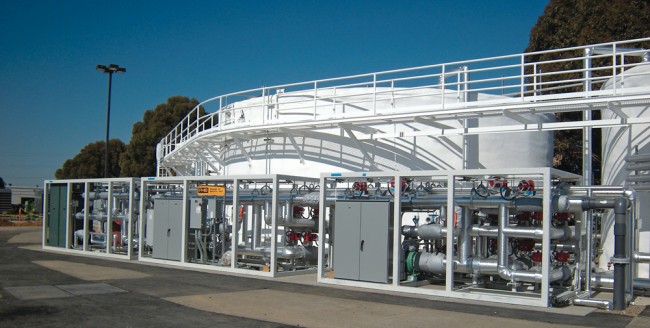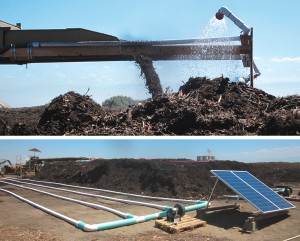To achieve its 75 percent goal, CalRecycle estimates California will need to move about
22 million more tons of organics and other recyclables from disposal to recycling annually.
Caroll Mortensen
BioCycle March 2013, Vol. 54, No. 3, p. 29

In California, we’re understandably proud of our tremendous success in recycling and reuse. Committed communities, enlightened businesses, and individual households have embraced the recycling ethic so vigorously that daily per person disposal has plunged from 8.4 pounds to 4.4 pounds.
Such lofty achievement begs the question: What is the next frontier in recycling? The answer is simply and undeniably, organics. Recycling food scraps, yard clippings and other materials into compost or bioenergy is critical to achieving the state’s new goal of 75 percent source reduction, recycling and composting by 2020. How do we get there? At CalRecycle, we have a vision for the next generation of solid waste facilities: An advanced statewide infrastructure that not only expands on the accomplishments California has made so far, but leverages new technologies that offer better environmental performance and that heavily target organics.
Not that organics is a new focus, or one that hasn’t taken steps forward in recent years. But for all our progress, organics still comprise one-third of material going to California landfills each year — and most of it, including 6 million tons of food, is compostable. Lumber and wood make up an additional 14 percent of landfilled waste that could instead be a resource.
To achieve our 75 percent goal, CalRecycle estimates California will need to move about 22 million more tons of organics and other recyclables from disposal to recycling annually. Aside from other challenges this presents, including dramatically steeper commitments by the residents and businesses of our state, additional diversion of this magnitude will require doubling the current organics infrastructure and expansion of recycling and remanufacturing in California.

The Clean World anaerobic digester installation at the South Area Transfer Station in Sacramento is designed to process 100 tons/day of source separated organics.
Compelling Case For Organics Recycling
The arguments for aggressively supporting organics recycling go far beyond reducing the volume of material in our landfills. The formidable nexus of economic, environmental and sustainability benefits are undeniable:
Recycling produces clean domestic energy. In Europe, more than 200 anaerobic digestion facilities process the putrescible portion of organic materials in the municipal solid waste stream and produce biogas that is used in a variety of ways. In North America, however, only a handful of these facilities are now in operation.
Organics recycling significantly lowers greenhouse gas emissions. As organic material decomposes in our landfills, it creates methane, a greenhouse gas 25 times more potent than carbon dioxide (CO2). Recycling rather than landfilling organics means less methane generated at the dump. We know that compost created from recycled organics improves soil health, increases soil carbon storage, prevents erosion, reduces the use of herbicides, and increases water retention in the soil. This in turn lowers the need to use emissions-producing machinery for pumping water, tilling the soil and applying herbicide. Additionally, when compost application reduces the amount of nitrogen-based fertilizers needed, it not only helps reduce emissions of nitrous oxide, a potent greenhouse gas with a global warming potential 298 times greater than CO2, but it can also improve California’s drinking water supply by reducing nitrate concentrations in agricultural leachate.
Recycling creates jobs. In California, the business of recycling supports more than 140,000 jobs. What’s more, recycling our waste creates more than twice as many jobs as when we dump it in the landfill. The 58 million tons of waste recycled in California in 2009 equates to as much as $6 billion in salaries and wages. If the materials we collect to reach the 75 percent goal are used to make new products, CalRecycle estimates more than 100,000 new jobs can be created in the state. Many of the jobs associated with expanded organics infrastructure are sustainable, because these facilities must be built and operated locally.
Recycling is good business practice. When we throw organics away, we are wasting a valuable, low-cost, easily accessible production material. It’s woefully inefficient and, frankly, just bad business to treat useful feedstock as trash.
Strengthening The Infrastructure
There are now about 120 commercial composting facilities across our state, although the volume of material they process has been static over the last several years. Besides traditional open windrow composting, anaerobic digestion (AD) is gaining acceptance as an organics platform in California. As more and more AD facilities are developed, they could eventually process millions of tons of organics each year.
CalRecycle has long supported commercial composting operations, and we’re eager to support the development of more AD facilities. Since its inception in 1993, our Recycling Market Development Zone loan program has provided more than $15 million for California organics recycling companies, including AD facilities. Clean World, a new AD facility in Sacramento that will eventually process 100 tons/day of food, launched recently thanks in part to a $2 million RMDZ loan.

CalRecycle has been collaborating on composting and air quality research, including methods to reduce VOC, ammonia and greenhouse gas emissions. In one study, a 1-foot-thick biofilter cap on aerated static piles has been very effective (pile construction process shown top). The project also is using solar power to run the aeration fans (bottom).
We are collaborating with the University of California, Davis and the San Joaquin Valleywide Air Pollution Study Agency on several technical research studies on composting and air quality. And we are working with the State Water Resources Control Board and stakeholders to develop statewide waste discharge requirements for current and future composting facilities. This will ensure the protection of water quality while balancing the need to expand the organics processing infrastructure.
The economics of recycling organic material versus landfilling has been another barrier to development of infrastructure. Low-cost landfilling makes it difficult for both composting and anaerobic digestion facilities to compete for feedstock. To this end, CalRecycle has collaborated with the California Energy Commission to provide grants from the commission’s alternative fuels program for a number of anaerobic digestion projects such as Clean World. Others include:
• A Ventura County project that involves construction of a bio-LNG (liquid natural gas) fueling facility that would produce enough LNG to fuel 500 waste hauling trucks.
• A Sonoma County project that will convert animal and food waste to pipeline-quality biomethane for PG&E and fuel 33 Sonoma County Transit fleet buses.
• An AD project in Oroville that would produce biomethane from rendering waste, including animal and slaughterhouse remains, to fuel a fleet of 14 trucks.
• A biogas facility in Pixley, which will use anaerobic digestion of cow manure from three local dairies to produce biogas, offsetting 13.1 percent of the total natural gas consumption at its existing Calgren ethanol facility.
• A South San Francisco facility, Blue Line Transfer, which proposes to produce fuel from anaerobic digestion of food waste.
• The City of Los Angeles, which plans to process 50,000 tons/year of mixed municipal waste through AD; the resultant biogas will be cleaned to pipeline quality.
AD facilities utilizing a portion of the digestible organic materials that are currently landfilled could produce on the order of 4 million megawatt hours of electricity, increasing in-state biopower production by around 40 percent.
In addition, CalRecycle is working closely with the California Air Resources Board (ARB) on recycling and composting elements of the ARB’s Climate Change Scoping Plan. This includes development of low-carbon fuel standards for anaerobic digestion, quantification of emission reduction factors for composting, and reassessment of methane emission estimates from landfills. We recognize, however, that more financial incentives are needed, and we are encouraged that the governor’s proposed budget for fiscal year 2013-1014 includes organics infrastructure as a possible use of cap-and-trade revenues.
We face many challenges, to be sure. But never before have the opportunities been more far-reaching. We can forge a new frontier in environmental protection with organics diversion and recycling. As we improve our collaboration with other agencies and find new ways to support and reward organics recycling, we can nourish a new economy, safeguard our resources and strengthen California’s future.
Caroll Mortensen is Director of the California Department of Resources Recycling and Recovery. Ms. Mortensen will be the opening speaker at BioCycle’s 27th Annual West Coast Conference on April 9, 2013.










